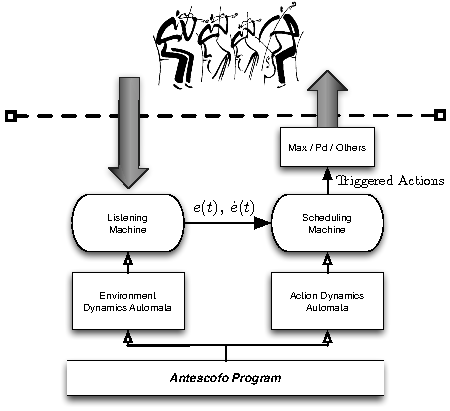Section: New Software and Platforms
Antescofo
Participants : Arshia Cont, Jean-Louis Giavitto, Florent Jacquemard, José Echeveste.
Antescofo is a modular polyphonic Score Following system as well as a Synchronous Programming language for musical composition. The module allows for automatic recognition of music score position and tempo from a realtime audio Stream coming from performer(s), making it possible to synchronize an instrumental performance with computer realized elements. The synchronous language within Antescofo allows flexible writing of time and interaction in computer music.
A complete new version of Antescofo has been released in November 2014 on Ircam Forumnet . This version includes major improvements over the previous version as a result of MuTant's research and development. Its development has benefited from of intensive interactions with composers, especially Julia Blondeau, José-Miguel Fernandez, and Marco Stroppa.
One major and sensible improvement is a total review of Antescofo's realtime machine listening as a result of [12] , which allows robust recognition in highly polyphonic and noisy environments with the help of novel notions of Probabilistic Time Coherency. This improvement allowed team members to participate in collaborative work with Paris Orchestra among others.
The 2014 release of Antescofo also includes new anticipative synchronization strategies. In the context of the PhD of José Echeveste, they are systematically studied with the help of the Orchestre de Paris and the composer Marco Stroppa. This work won the best presentation award at ICMC 2014.
The new internal architecture unifies the handling of external (musical) events and the handling of internal (logical) events in a framework able to manage multiple time frames (relative, absolute or computed). The notion of synchronization has been extended to be able to synchronize on the update of a variable in addition to the update of the listening machine. This mechanism offers new opportunities, especially in the context of open scores and improvised music [16] .
The 2014 version targets the Max and PureData (Pd) environments on Mac, but also on Linux on Windows (Pd version). A standalone version is used to simulate a performance in Ascograph and to offer batch processing capabilities as well as a testing framework.


